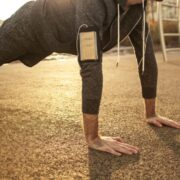CEO Corner: Endel’s Oleg Stavitsky on the Power of Functional Sound

Endel is on a mission to become the “Spotify of functional audio,” Stavitsky tells Athletech News in an exclusive interview
Endel, a generative music app that creates personalized sound environments to match user activities, is on a mission to help users relax, focus and sleep. The app reacts to the time of day, weather, user heart rate and location to create unique compositions. Powered by neuroscience, Endel conducted a survey that demonstrated users’ 7x increase in focus and 3.6x decrease in stress with regular use.
To learn more about Endel’s unique approach to sound environments, Athletech News spoke with Oleg Stavitsky, CEO and co-founder at Endel, about why the company has been so successful, what’s in store for the functional sound market and how to improve one’s sleep quality.
Athletech News: Tell us a bit about your background and what led you to create Endel.
Oleg Stavitsky: It’s not just my background we have to talk about. Endel has six co-founders and I’m one of them. We’ve collectively worked for over 10 years together, and before Endel we had built another company that was called Bubl, which was a digital art app for kids. That company was acquired here in Germany by Fox & Sheep, which at the time was one of the biggest kids app publishers and developers in the world. So we all moved to Berlin, and when Fox & Sheep themselves got acquired by Haba, which is a German toy-manufacturing company, we all left and almost immediately transitioned to start Endel.
The six of us are almost like a family. We call ourselves an artistic collective. Sound always played a very important role in everything that we do, and back in 2017 when we were thinking about what we were going to work on next we just saw this emerging functional sound space taking off. Apple at the time just released their Airpods, so it was clear that the smart speaker revolution was there and sound was becoming increasingly more mobile. It wasn’t just music – all of those functional sound playlists had been growing – so we felt like there was a product to be built. This category needed a proper product and thus Endel was born.
ATN: Why is Endel’s approach to sleep health unique?
OS: For two reasons. Number one, because this proprietary, patented, scientifically validated technology that we’ve built generates sleep soundscapes personalized to you. No one else in the market is doing something like this. We built our soundscapes in consultation with world-leading sleep scientists. For example, Dr. Roy Raymann, who designed Apple’s bedtime functionality, helped us design Endel sleep soundscape.
Number two, unlike everybody else, we’re thinking about sleeping phases, because you can’t just say “sleep health.” When you say sleep, you need to think about a wind-down phase, which begins before you’re even in bed. This is when your parasympathetic nervous system in theory should be activated. That means your blood pressure goes down, your muscles relax and your body prepares itself for a sleep session. Then the so-called sleep onset phase is when you’re in bed, but not asleep yet. The quality of that phase is determined by how quickly you fall asleep. In the sleep phase itself, the quality is determined by how many times you wake up throughout the night. Obviously, the less the better.
So, our approach is unique because we’re firmly rooted in neuroscience and because we create our soundscapes using generative AI. These two things combined make our soundscapes unlike anything else on the market.
ATN: What gap is Endel filling in the market?
OS: When we talk about the market, I talk about the functional sound market, which is this vast ocean of content. That largely consists of white noise soundscapes or playlists with white noise or dishwasher sounds or fan sounds. There’s just a lot of, I don’t want to say junk, but there’s a lot of content that can’t be qualified as music. Yet, it’s there. People listen to it, and then someone collects royalties on that.
We believe there’s a gap, in the sense that there’s no artist-driven, scientifically engineered sleep content in the functional sound space. So this is the gap that we’re filling because we’re building our sleep soundscapes not only in collaboration with world-class sleep scientists, but we’re also building them in collaboration with some of the biggest artists on the planet, like Grimes and James Blake. We have collaborated with both of them.
The future that we’re imagining is that more and more of your favorite music artists are going to start releasing their sleep soundscapes in collaboration with Endel. Very soon you’ll be able to fall asleep to many of your favorite artists.
ATN: If you had to give three tips for better sleep, what would they be?
OS: Number one, no blue light, or ideally no computers and no gadgets, at least one hour before bedtime. Number two is temperature. You want your bedroom to be cool because your body actually needs to lower its temperature in order to fall asleep.
Number three, use Endel. Because in reality, you can’t always do the first two tips for various reasons.
ATN: Can you explain the importance of functional music?
OS: I think the importance of functional music kind of explains itself because sound is very powerful and it’s the easiest way to control your environment. The fact that functional music as a market is rapidly growing is just a testament to the power of sound and the power of music. A lot of people have recognized that, and they are turning to sound to help them feel better or feel different. They’re self-medicating with sound. People are using sound to help them fall asleep. They’re using sound to help them concentrate, to help them overcome panic attacks and anxiety or to help them meditate.
Functional music in general is extremely important and as a category, it’s only going to grow. Today we estimate it to be 10 billion streams a month across all platforms and DSPs, which is roughly 5% of all music listened to. I think this category is on track to be 10% if not more, of all music listened to on the planet.
ATN: What are Endel’s goals, both short- and long-term?
OS: Endel has two goals. Number one, we’re building Endel into the platform for functional sound, and that means that we see ourselves as the Spotify of functional audio. That is a long-term goal. In order to get there we want to power the traditional music industry. We want to help music artists expand into this category by using our technology.
Short-term, we want to use our technology to turn your favorite music into functional soundscapes so that you can fall asleep, relax and focus with a scientifically engineered soundscape version of your favorite music. That in turn is going to pave the way for Endel to become the platform for functional sound.



